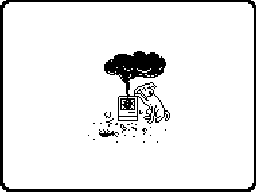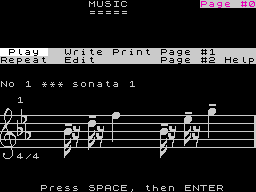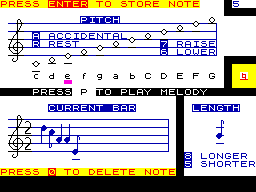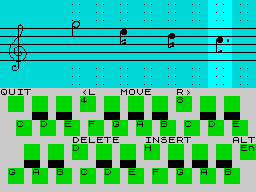ON BOARD OPTIONS
You've got three basic parameters to play with in order to make music, and they can all be found in chapter 19 of the Spectrum manual; they are, of course: BEEP - the frequency or pitch of the note; PAUSE - the time before the next note; and duration - the 'on-time' of the note. Circumventing the need to get too musical, the Spectrum allows the pitch to be expressed in numerical terms, with middle C at '0', concert A at '9' and the C below middle C at '-12'. Duration of the note and pauses are expressed as '1' for a one second burst, '.5' for a half a second, and so on. By using a look-up table, it'sThere are a number of musical utilities on the market and I've chosen five which purport to extend the musical capabilities of the Spectrum. It's best to have a good idea of what you're looking for in a music package - do you want to learn how to write music, play pretty tunes, or both? As you'll see from the five packages I've looked at here, they do vary quite dramatically in their musical awareness, and if you imagine that they've had the same programming dedication lavished on them as on much of today's games software, you're in for a shock!
Please be extremely careful when choosing the right program to buy - some can be really disappointing.
T H E
M U S I C
| MUSIC MAKER |
Supplier: Malan Associates, xx xxx nnn, xxxxxxxx, xxxxx xxn nxx.
This package offers little instruction on its use other than the blurb on the badly printed paper index card. This is a shame, because I found it quite easy to use - the only exception being that A Green (the programmer) decided to use a 10-line stave instead of the five line standard. As much as we need innovation in the world of music, I'm afraid this only adds to the confusion.
The screen information was enough to help me to store notes with ease but, unfortunately there's no facility to introduce sharps and flats! This, of course, makes the program musically unusable. But even worse, on playback it turns out that the notes are not what they say they are; for instance, a scale of C turns out to be a row of semitones starting from C and ending with G!
I think A Green would be well advised to take some music instruction before attempting any more music programs!
| PLAY, TYPE AND TRANSPOSE |
Supplier: Hilton Computer Services, xxxxxx xxxx, xxxxxxxxx, xxxx xxn nxx.
This software package comes complete with a seven-page manual, which tells you that the Play program plays tunes entered as a series of BEEP and PAUSE Basic statements. The question is, why was the program written at all?
Having loaded the cassette, you're asked how many sharps and flats are required; the problem here is that your
The other program in this package is Music Typing and Transposing which is much the same as Play - tedious and boring.
| MUSIC TYPEWRITER |
Supplier: Romantic Robot, nnn xxxxxxx xxxxxx, xxxxxx xxn.
This package contains a very fast and easy-to-use non-real time sequencer that can process up to 16 tunes in memory. The writing and editing facilities are slightly easier to use than on Spectune, but then they're also musically more precise. You're even able to use complex timings like triplets and staccato notes with this package.
But the exceptional part has got to be the notation - it has to be seen to be believed! The way Music Typewriter prints up musical notation on-screen puts many expensive professional computer music systems to shame. The notes are tied together when necessary and, when in play mode, the music's printed out as the piece is played. The accuracy, even at fast speeds, is
But, unlike his great-grandfather Richard Wagner, Adrian's not just concerned with writing music, he's also heavily involved with the production of synthesisers. Adrian was instrumental in the invention of the Wasp and Gnat synthesisers and, at present, he's working with Francis Monkman (ex-Sky and Curved Air) on a long-term project that they hope will revolutionise the synthesiser as we know it today.

Music Maker: Not one of the most brilliant pieces ot coding I've come across, but then it's one of Malan's budget range for just under two quid! Sad graphics and poor use of colour are the first things you'll notice - but this is nothing to the lack of musical awareness shown by the program's designer; for instance, how many sheets of music manuscript have you seen with ten ledger lines? Altogether, a very confusing program and not really worthwhile if you have musical aspirations. 1/5 Peter Shaw

Music Typewriter: This is certainly one of the most professional music editors I've seen! Out of the five packages here, Music Typewriter sports the best musical notation (the graphics are excellent!) and speed, plus a very easy-to-use editor that incorporates a full error-check of the length of each bar. It also comes with a keyboard overlay - which isn't much use if you've got a replacement keyboard or a Speccy+, but it's a nice thought. 4/5 Peter Shaw

